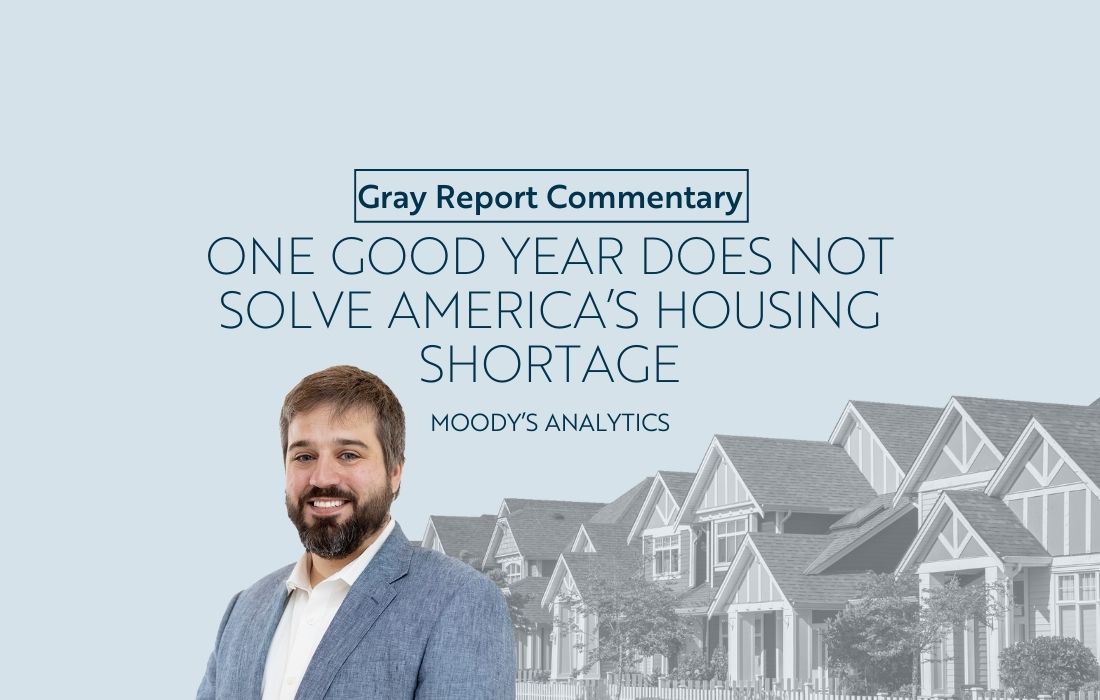Economy
NMHC Insights on the Apartment Market in 2024
The enormous amount of apartment supply expected this year should temper any expectations of apartment demand, but newly-published research on the topic argues that U.S. housing needs are far larger than can be addressed even with the historic amount of multifamily completions last year and forecasted for this year. On the capital markets side, recent data points to a substantial…
GO >One Good Year Does Not Solve America’s Housing Shortage
Source – Moody’s Analytics: “One Good Year Does Not Solve America’s Housing Shortage” Multifamily construction projects increased by 11.1% in succession, reaching a seasonally adjusted annual rate of 509,000 units. However, household formation and mobility, which were high during the last half of 2021 and early half of 2022 due to lifestyle changes, location preferences,…
GO >Gray Report Newsletter: February 1, 2024
Are We Underestimating Apartment Demand? The enormous amount of apartment supply expected this year should temper any expectations of apartment demand, but newly-published research on the topic argues that U.S. housing needs are far larger than can be addressed even with the historic amount of multifamily completions last year and forecasted for this year. On…
GO >Eye to Eye with Apartment Supply
While recent migration and employment data highlights the continued growth of the Sunbelt, the massive amount of newly-built apartments in Sunbelt markets far outweigh the effects of demand drivers like population or job growth. Given this dynamic, investors may find higher-performing assets in multifamily markets in the Midwest and Northeast that have not seen as…
GO >Gray Report Newsletter: January 25, 2024
Where Will Apartment Supply Hit Hardest? With record levels of new apartment supply a near-certainty for 2024, finding the markets with the most attractive balance of supply and demand will be a priority for multifamily investors. Asset valuations remain in flux given the sluggish apartment sales market, but greater optimism and clarity on interest rates…
GO >Top Multifamily and Housing Markets for 2024
Markets in the Northeast and the Sun Belt continue to get attention, along with mountain locales like Idaho and Montana, but affordability is a significant draw for Midwestern markets like Cincinnati and Indianapolis.
GO >Gray Report Newsletter: January 18, 2024
Will the Multifamily Market Reignite? A number of potential scenarios could restart activity in the multifamily market, with rate cuts, pent-up investor demand, loan maturities, and continued operational challenges among the possible factors that could close the buy/sell gap and motivate more apartment property sales. Multifamily asset performance faces near-term pressures from increased apartment supply…
GO >Private Credit and Multifamily Survival
Recent reporting on commercial real estate financing has highlighted the role of private credit in providing funding for CRE sponsors/owners and delaying the need for a capital call, and despite the expectation of interest rate reductions later in the year, it is clear that private credit will remain an important tool in 2024. Newly-published reports…
GO >Gray Report Newsletter: January 11, 2024
Private Credit and Multifamily Survival Recent reporting on commercial real estate financing has highlighted the role of private credit in providing funding for CRE sponsors/owners and delaying the need for a capital call, and despite the expectation of interest rate reductions later in the year, it is clear that private credit will remain an important…
GO >Timing Interest Rates and the Multifamily Market
While the continued surge in newly-constructed apartments is relatively unchanged from 2023, the outlook for 2024 interest rates is less clear. The longer-term prospects for the multifamily market remain strong, but given the continued pressure from apartment supply, investors who speculate on lower interest rates and future asset valuation increases could be vulnerable to short-term…
GO >









